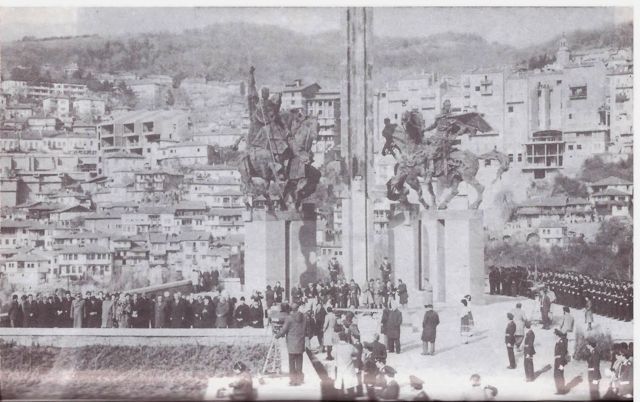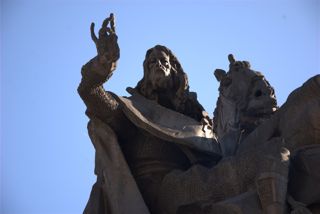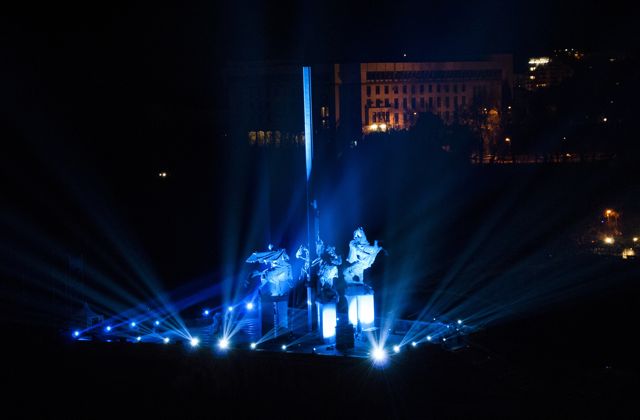Photos: the author
Polina Spartyanova
A remarkable monument to the Asen dynasty stands out in the capital of the Second Bulgarian Empire Veliko Tarnovo. It was built in 1985 on a rocky promontory at one of the bends in the Yantra River to celebrate 800 years since the rebellion of the Asen and Peter brothers. The uprising of the brothers broke out on 26 October 1185 and took place during the Byzantine rule over the Bulgarian lands in what is now northern Bulgaria. Their insurgent activities lasted two years and culminated with success, and in the spring of 1187, Byzantine Emperor Isaac II Angelos concluded a truce with them, thus recognizing the resumption of the Second Bulgarian Empire north of the Balkan Mountains.
The state was headed by the older brother, Asen, who took the name Ivan Asen I. However, the composition of the monument includes two of the rebel brothers’ heirs to the throne, namely Tsar Kaloyan, the younger brother of Tsar Ivan Asen I, who ruled Bulgaria after the death of the first tsar of the Second Bulgarian Empire. While the first two tsars of the Asen dynasty sought to establish state centralism in the national politics and restore the previous Bulgarian borders in terms of foreign policy, their younger brother Kaloyan continued to successfully implement their policies, being able to significantly expand the territory of Bulgaria. However, the policy of the first three members of the Asen dynasty was finally realized during the reign of their successor Tsar Ivan Asen II, who is the forth figure in the composition of the monument. He conquered huge territories thus expanding the borders of Bulgaria to three seas, and in 1230, during the Battle of Klokotnitsa, he defeated the Byzantine army and captured emperor Theodore Komnenos and his family.

The construction of the monument took place under the guidance of Professor Krum Damyanov and the overall layout of the surrounding area was completed within one year. It took just two months to make the monument, which turned it into a unique example in global practice. A revolutionary technical solution in this monument is that it is composed in such a way that two of the riders are standing, balanced only on the horses’ hind legs. In Europe there are few such structures made of special Japanese steel, which acts as a spring.
In the middle of the composition of the monument there is a high metal sword, with its edge upwards, that symbolizes the power and the rise of the Second Bulgarian Empire and the zeal for eternity of the Bulgarian nation. Under its handle there is a granite figure of Virgin Orans, the heavenly mother, who creates and protects life. The reasons for placing it there are not clear, as this symbol is relatively unusual for the social realism monuments in Bulgaria, as they in no way admit the belief in a religion or in something that is more senior than the communist party is. Sometimes the figure of a woman is put in the centre of some monuments of this kind, symbolizing the image of "Mother Bulgaria" suffering for her sons and daughters who died in the name of their homeland.
The four equestrians are placed on granite pedestals that are 7 metres high and the total height of  the monument is 15 metres. The equestrians surrounding the high metal sword are made of bronze and weigh about 11 tons, and each of them is depicted in a different way, to underline the individual contribution to the Second Bulgarian Empire of each of them. The eldest brother of the Asen dynasty, Peter, is depicted with a blessing gesture that symbolizes the belief in the Christian religion and God's help for the Bulgarian rebellion activity. The younger Ivan Asen I boldly holds the bridle of his horse and his sword, ready to act, which symbolizes his strong will to preserve the independence of the Second Bulgarian Empire. The two brothers are on the two horses of the composition that stand on their hind legs and balance their weight through a special technology. The youngest brother, Kaloyan, belligerently looks at the territorial expansions of Bulgaria and is in a cautious readiness to protect them whereas Tsar Ivan Asen II is on top of his glory as he wears a crown and spear with which he pierced the parchment of the broken peace treaty between Bulgaria and the Latin Empire.
the monument is 15 metres. The equestrians surrounding the high metal sword are made of bronze and weigh about 11 tons, and each of them is depicted in a different way, to underline the individual contribution to the Second Bulgarian Empire of each of them. The eldest brother of the Asen dynasty, Peter, is depicted with a blessing gesture that symbolizes the belief in the Christian religion and God's help for the Bulgarian rebellion activity. The younger Ivan Asen I boldly holds the bridle of his horse and his sword, ready to act, which symbolizes his strong will to preserve the independence of the Second Bulgarian Empire. The two brothers are on the two horses of the composition that stand on their hind legs and balance their weight through a special technology. The youngest brother, Kaloyan, belligerently looks at the territorial expansions of Bulgaria and is in a cautious readiness to protect them whereas Tsar Ivan Asen II is on top of his glory as he wears a crown and spear with which he pierced the parchment of the broken peace treaty between Bulgaria and the Latin Empire.
Nowadays, the monument to the Asen dynasty is one of the most attractive places in Veliko Tarnovo and every tourist has a picture against its background. Every year in late May, all graduates come here to say "farewell" to their school years, and many young couples marry at this place all year round. For several years already, during the day of Veliko Tarnovo on 22 March, which is associated with the victory of Ivan Asen II over the ruler of Epirus Theodore Komnenos in the Battle of Klokotnitsa the same day, the monument has become the scene of 3D mapping and a laser show.
